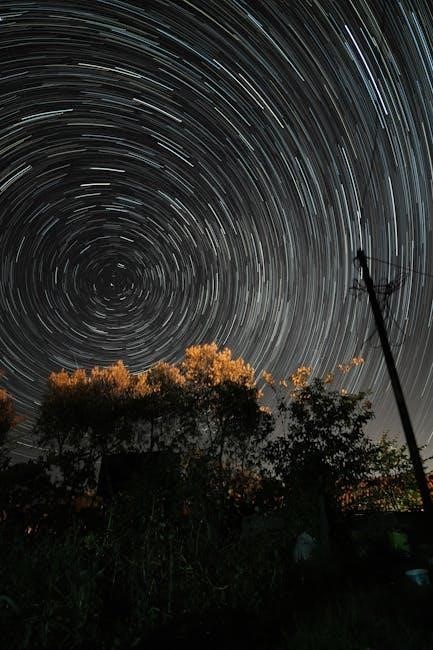
Welcome to our comprehensive guide to the stars, where we explore the universe’s wonders, from celestial mechanics to cultural significance, and provide practical stargazing tips for all.
1;1 Overview of the Stars and Their Significance
Stars are massive balls of hot, glowing gas, primarily composed of hydrogen and helium, that generate energy through nuclear fusion. They are the fundamental building blocks of galaxies, including our Milky Way. Stars play a crucial role in creating the elements necessary for life and shaping the universe’s structure. Their light and heat sustain planets, enabling the existence of life as we know it. Culturally, stars have inspired myths, art, and navigation systems, symbolizing guidance and wonder. Scientifically, they provide insights into cosmic phenomena, such as black holes and galaxies, helping us understand the universe’s origins and evolution. Stars are not just celestial objects but key to unraveling the mysteries of space and our place within it.
1.2 Importance of Understanding the Stars
Understanding the stars is essential for advancing our knowledge of the universe and its workings. Stars provide insights into the fundamental laws of physics, such as gravity, nuclear fusion, and energy production. By studying their properties, we gain a deeper understanding of celestial mechanics, which aids in navigation, weather prediction, and space exploration. Stars also play a critical role in technological advancements, inspiring innovations in optics, computing, and engineering. Furthermore, their study fosters a sense of wonder and curiosity, driving scientific inquiry and inspiring future generations. The importance of stars extends beyond science; they have shaped human culture, influencing art, literature, and mythology. In essence, understanding the stars enriches both our scientific and cultural understanding of the cosmos.
History of Stargazing
Stargazing has captivated humanity since ancient times, with early civilizations using celestial observations to guide agriculture, navigation, and spiritual practices, laying the foundation for modern astronomy.
2.1 Ancient Civilizations and Their Mythologies
Ancient civilizations deeply connected the stars to their mythologies, creating stories that explained celestial phenomena. Greeks linked constellations to gods like Orion and Cassiopeia, while Egyptians associated stars with pharaohs’ immortality. Mesopotamians developed zodiac signs, blending astrology with agriculture. These myths served as cultural frameworks, guiding beliefs, rituals, and even navigation. Early societies saw the heavens as divine, influencing their calendars and spiritual practices. Such storytelling not only preserved knowledge but also laid the groundwork for later astronomical discoveries, showcasing humanity’s enduring fascination with the cosmos and its mysteries. These ancient tales remain a testament to how stargazing shaped human culture and understanding of the universe. Their legacy continues to inspire wonder and exploration today.
2.2 The Role of Astronomy in Early Societies
Astronomy played a pivotal role in early societies, serving as a foundation for agriculture, navigation, and cultural practices. Ancient peoples observed celestial patterns to predict seasonal changes, aligning their planting and harvesting cycles with lunar and solar movements. This knowledge was crucial for survival, enabling communities to optimize food production and resource management. Astronomy also influenced decision-making, with leaders often consulting celestial events to guide important actions. Early tools like sundials and calendars were developed to track time and predict eclipses or planetary alignments. These practices not only advanced practical skills but also fostered a deeper understanding of the cosmos, laying the groundwork for scientific inquiry and inspiring curiosity about the universe’s workings. Astronomy became a cornerstone of early civilizations, blending practicality with philosophical wonder.
2.3 Evolution of Stargazing Tools and Techniques
The evolution of stargazing tools and techniques has been a remarkable journey, transforming our ability to observe and understand the cosmos. Early civilizations relied on simple tools like stone circles and astrolabes to track celestial movements. The invention of the telescope in the 17th century revolutionized astronomy, allowing deeper exploration of the universe. Over time, reflecting telescopes and radio telescopes expanded our observational capabilities; Modern advancements include CCD cameras, space-based observatories, and adaptive optics, enabling sharper and more detailed images of distant objects. These innovations have not only enhanced our understanding of the universe but also made stargazing more accessible to amateur astronomers, fostering a growing community of sky enthusiasts.

The Universe and Its Components
The universe is vast, comprising countless galaxies, stars, and celestial phenomena. This section explores its structure, from galaxies to star types, offering insights into cosmic composition and dynamics.
3.1 Galaxies and Their Structure
Galaxies are massive cosmic systems, each containing billions of stars, planets, and interstellar gas. The Milky Way, our home galaxy, is a barred spiral, with a central bulge and arms of stars. Galaxies vary in shape, including spirals, ellipticals, and irregulars, each formed by gravitational forces. Dark matter plays a crucial role in their structure, providing the gravitational glue. Supermassive black holes reside at many galaxies’ centers, influencing their evolution. Understanding galaxy formation helps us trace the universe’s history, revealing how matter clumped after the Big Bang. Observing galaxies offers insights into star birth and cosmic dynamics, shaping our view of the cosmos.
3.2 Star Classification and Types

Stars are classified based on their spectral characteristics, primarily temperature and luminosity. The Harvard Spectral Classification system categorizes stars into types O, B, A, F, G, K, and M, with O being the hottest and M the coolest. Additionally, stars are grouped into main-sequence, giants, and white dwarfs. Main-sequence stars, like our Sun, are in the stable part of their life cycle. Giants are larger and brighter, while white dwarfs are dense remnants of stars. Other types include neutron stars and black holes, formed from massive stars’ collapses; Understanding these classifications helps in studying stellar evolution and the diverse roles stars play in the universe. This system aids astronomers in identifying and analyzing celestial bodies effectively;
3.3 Celestial Events: Eclipses, Meteor Showers, and More
Celestial events captivate astronomers and enthusiasts alike, offering glimpses into the universe’s dynamic nature. Eclipses occur when celestial bodies align, such as the Moon blocking the Sun’s light during a solar eclipse or Earth’s shadow falling on the Moon during a lunar eclipse. Meteor showers, like the Perseids, happen when Earth passes through trails of comet debris, producing streaks of light in the sky. Planetary alignments and comets also draw attention, showcasing rare configurations and icy bodies approaching Earth. These events provide opportunities for scientific study and public wonder, highlighting the beauty and complexity of our cosmos.

Practical Guide to Stargazing
Master the art of stargazing with essential tips on choosing equipment, locating dark skies, and timing observations for optimal celestial views and unforgettable astronomical experiences.
4.1 Choosing the Right Equipment for Stargazing
Choosing the right equipment is crucial for a rewarding stargazing experience. For beginners, binoculars or a basic telescope are ideal, offering clear views of celestial objects. Ensure your telescope has a sturdy tripod for stability and a wide aperture for better light collection. Red-light flashlights preserve night vision, while star charts or apps help navigate the sky. Invest in eyepieces of varying magnifications to explore different details. Dress warmly and bring a star chart or sky map to enhance your observation sessions. Remember, quality over quantity—start with essential tools and upgrade as you gain experience and understanding of the night sky.
4.2 Finding the Best Locations for Star Observation
Finding the best locations for stargazing involves seeking dark, remote areas with minimal light pollution. National parks, remote deserts, and high-altitude sites offer the clearest views. Light pollution maps or apps can help identify ideal spots. Ensure the location is far from cities and artificial light sources. Observing from higher elevations reduces atmospheric interference, providing sharper star images. Coastal areas with low humidity can also enhance visibility. Always check local regulations and accessibility before heading out. Plan your visits during new moons to avoid moonlight interference. Patience and the right location are key to a memorable stargazing experience.
4.3 Using Star Charts and Apps for Navigation
Star charts and apps are essential tools for navigating the night sky, helping you identify constellations, planets, and celestial events. Apps like Sky Map or Stellarium Mobile provide real-time star maps based on your location. These tools allow you to pinpoint stars, track movements, and even receive alerts for meteor showers or eclipses. For beginners, they simplify stargazing by offering interactive guides to the sky. Offline charts are useful in areas with limited internet access. Combining traditional star charts with modern apps enhances your stargazing experience, making it easier to explore and understand the universe. They are indispensable for both casual observers and serious astronomers, fostering a deeper connection to the cosmos.
4.4 Tips for Amateur Astronomers
For amateur astronomers, patience and persistence are key. Start with binoculars or a beginner-friendly telescope to observe bright objects like the Moon, planets, or constellations; Dress warmly and allow your eyes to adapt to the dark for better visibility. Begin with easy-to-find celestial objects and gradually explore more complex targets. Join local astronomy clubs or online communities for support and knowledge sharing. Use apps to locate constellations and track celestial events. Keep a journal to record observations and progress. Remember, stargazing is a journey—enjoy the process and stay curious about the universe!

The Science Behind the Stars
Explore the fascinating science of stars, including their formation, life cycles, and energy production, to gain a deeper understanding of the universe’s fundamental processes and elements.
5.1 The Life Cycle of Stars
The life cycle of stars is a captivating journey that spans millions to billions of years. It begins with the collapse of molecular clouds, leading to protostars. As nuclear fusion ignites, stars enter their main sequence phase, where they fuse hydrogen into helium. Massive stars end their lives in supernovae, dispersing heavy elements, while smaller stars like our Sun expelled their outer layers, forming planetary nebulae, leaving behind white dwarfs. The remnants of massive stars become neutron stars or black holes. This cycle drives the cosmic evolution, enriching galaxies with the materials necessary for new star formation and life.

5.2 Understanding Light-Years and Distances in Space
A light-year is the distance light travels in one year, approximately 5.88 trillion miles. It’s a unit used to measure vast cosmic distances. Understanding light-years helps grasp the scale of the universe, as stars and galaxies are often millions to billions of light-years apart. For example, the nearest star, Proxima Centauri, is about 4.24 light-years away, while the Milky Way spans roughly 100,000 light-years. Comprehending these distances reveals the immense scale of space and the time it takes for light to travel, emphasizing how distant celestial objects appear as they were in the past due to light’s finite speed.
5.3 The Role of Gravity in Star Formation
Gravity plays a central role in star formation by pulling together molecular clouds of gas and dust. As these clouds collapse under gravity, they spin faster, flattening into disks. At the center, dense cores form, which eventually become protostars. Gravity continues to compress the core, raising temperatures and densities until nuclear fusion begins, marking the birth of a new star. This process highlights how gravity shapes the structure and evolution of stars. Without gravity, the formation of stars and galaxies as we know them would be impossible, making it a fundamental force in cosmic creation and the organization of matter in the universe.

Cultural Significance of Stars
Stars have deeply influenced human culture, inspiring myths, art, and festivals worldwide, reflecting our curiosity and connection to the cosmos across centuries and civilizations.
6.1 Constellations and Their Stories
Constellations, like Orion and Cassiopeia, are patterns of stars with rich mythological tales, often reflecting ancient cultures’ beliefs, heroes, and natural phenomena. These stories, passed down through generations, have shaped human understanding of the cosmos, serving as navigational aids and cultural symbols. From Greek myths to Indigenous legends, constellations embody the creativity and curiosity of early societies, linking celestial beauty to earthly experiences. Their stories continue to inspire art, literature, and even modern-day festivals, bridging the gap between the stars and our shared human heritage.
6.2 Star Festivals and Celebrations Around the World
Star festivals worldwide celebrate celestial beauty, blending culture and astronomy. Japan’s Tanabata honors the Vega and Altair stars with wishes on bamboo trees. China’s Qixi Festival commemorates the Milky Way’s annual alignment, symbolizing love. India’s Pongal includes stargazing rituals during its harvest celebration. Mexico’s Noche de Rabanos features star-themed art and lanterns. These events unite communities, reflecting the universal allure of the night sky. They highlight humanity’s enduring connection to stars, fostering wonder and cultural exchange. From ancient traditions to modern gatherings, star festivals continue to inspire and educate, celebrating the cosmos’ timeless charm.
6.3 The Influence of Stars on Art and Literature
Stars have long inspired art and literature, symbolizing wonder, mystery, and the infinite. Painters like Van Gogh captured the cosmos’ beauty in works like Starry Night, while poets like Frost and Blake used celestial imagery to explore human emotions. Shakespeare often referenced stars in his plays to reflect fate and destiny. In literature, stars frequently symbolize hope, as seen in works like Wuthering Heights; Mythologies worldwide, such as Greek constellations, have shaped cultural narratives. Modern media, from music to film, continues this tradition, using stars as metaphors for love, ambition, and the unknown. The cosmic allure of stars remains a timeless muse, bridging art and astronomy in profound ways, inspiring creativity across generations and mediums.

Modern Space Exploration
Modern space exploration is driven by cutting-edge technology and global collaboration, pushing the boundaries of human knowledge and inspiring future generations to explore the cosmos.
7.1 The Role of Space Agencies in Star Research
Space agencies like NASA, ESA, and others play a pivotal role in advancing star research through mission planning, funding, and technological innovation. These organizations oversee groundbreaking projects, such as the James Webb Space Telescope, which captures unprecedented images of distant galaxies. By collaborating internationally, space agencies pool resources to explore cosmic phenomena, from exoplanets to black holes. Their work involves launching satellites, conducting experiments, and analyzing vast datasets to unravel the mysteries of the universe. These efforts not only expand scientific knowledge but also inspire global interest in astronomy. The collective impact of space agencies drives humanity’s quest to understand the cosmos and its endless wonders.

7.2 Breakthroughs in Space Technology
Recent advancements in space technology have revolutionized our ability to explore and understand the universe. Innovations such as reusable rockets, advanced propulsion systems, and cutting-edge telescopes like the James Webb Space Telescope have significantly enhanced our capabilities. AI integration and quantum computing are also playing roles in data analysis and mission planning. These breakthroughs enable deeper exploration of galaxies, exoplanets, and cosmic phenomena. Additionally, private companies like SpaceX and Blue Origin are driving innovation, pushing the boundaries of space travel and accessibility. Such technological progress not only expands scientific knowledge but also opens doors to new possibilities in space tourism and interstellar research, inspiring future generations to pursue careers in astronomy and engineering.
7.3 Citizen Science Projects for Star Exploration
Citizen science projects are empowering individuals to contribute to star exploration, fostering a collaborative approach to astronomical research. Platforms like Zooniverse allow volunteers to analyze galaxy images, classify stars, and identify celestial phenomena. These initiatives democratize astronomy, enabling anyone with an interest in the cosmos to participate. By leveraging collective effort, citizen science accelerates discoveries, such as identifying exoplanets or mapping star formations. Volunteers often work alongside professional researchers, providing valuable insights and data. Such projects not only advance our understanding of the universe but also inspire public engagement and education. They highlight how collective curiosity can drive scientific progress, making space exploration more accessible and inclusive for all. This grassroots approach to astronomy is reshaping how we explore the stars and beyond.

The Future of Stargazing
The future of stargazing promises exciting advancements, with next-generation telescopes, space tourism, and AI-driven discoveries set to revolutionize how we explore and understand the cosmos.
8.1 Advances in Telescope Technology
Recent advancements in telescope technology are transforming stargazing, enabling deeper exploration of the universe. Next-generation telescopes, such as the James Webb Space Telescope, utilize cutting-edge optics and sensors to capture high-resolution images of distant galaxies and stars. These instruments are capable of observing phenomena in unprecedented detail, from the formation of stars to the detection of exoplanets. Additionally, the development of adaptive optics and space-based telescopes minimizes atmospheric interference, providing clearer views of celestial objects. These innovations are paving the way for new discoveries, allowing astronomers and enthusiasts alike to study the cosmos with greater precision and accuracy than ever before.
8.2 The Potential for Space Tourism
Space tourism is emerging as a groundbreaking frontier, offering individuals the chance to explore the cosmos firsthand. Companies like Virgin Galactic and Blue Origin are pioneering suborbital flights, while others aim to provide orbital experiences and even lunar trips. These ventures are making space travel more accessible, though costs remain high. The potential for space tourism extends beyond adventure, fostering education, scientific research, and a deeper public connection to space. As technology advances, the industry is expected to grow, with possibilities for space hotels and longer missions. However, challenges like safety, affordability, and environmental impact must be addressed to ensure sustainable growth in this exciting field.
8.3 The Role of AI in Star Mapping and Research
Artificial Intelligence is revolutionizing star mapping and research by enabling unprecedented precision and efficiency. Machine learning algorithms analyze vast datasets from telescopes, identifying patterns and anomalies that humans might miss. AI-powered systems can predict celestial events, such as supernovae or black hole mergers, and optimize telescope observations. Natural Language Processing aids in analyzing historical astronomical texts, uncovering new insights. Additionally, AI-driven simulations model star formation and galaxy evolution, helping scientists understand cosmic phenomena. These advancements accelerate discoveries, enabling deeper exploration of the universe. As AI continues to evolve, its role in stargazing and research will expand, fostering breakthroughs and inspiring new generations of astronomers and enthusiasts alike.
This guide has explored the wonders of the stars, blending science, culture, and practical tips. As we gaze upward, the universe’s mysteries await, inspiring future generations to explore endlessly.
9.1 The Enduring Appeal of the Stars
The stars have captivated humanity for centuries, inspiring wonder, curiosity, and a deep connection to the cosmos. Their timeless beauty and mystery transcend cultures and generations, fostering a universal sense of awe. From ancient myths to modern astronomy, the stars have played a central role in human history, sparking both scientific inquiry and artistic expression. Their enduring appeal lies in their ability to remind us of our place within the vast expanse of the universe, while also fueling our imagination and quest for knowledge. As we continue to explore the stars, their allure remains a constant source of inspiration and discovery.
9.2 Encouraging Future Generations to Explore the Cosmos
Insisting future generations to explore the cosmos is crucial for advancing our understanding of the universe. By fostering curiosity and passion for astronomy in young minds, we ensure a legacy of discovery. Education plays a vital role, as schools and organizations can introduce stargazing and space science early on. Encouraging participation in citizen science projects and providing access to telescopes can deepen engagement. Additionally, sharing inspiring stories of astronauts and scientists highlights the rewards of pursuing careers in STEM fields. Mentorship programs and community stargazing events can further ignite interest. Together, these efforts can empower the next generation to not only explore the stars but also push the boundaries of space exploration and research.
 guiding light alan spaulding
guiding light alan spaulding  jewelry gift guide
jewelry gift guide  avatar frontiers of pandora trophy guide
avatar frontiers of pandora trophy guide  self portrait size guide
self portrait size guide  2024 ford trailer tow guide
2024 ford trailer tow guide  bcps study guide
bcps study guide  valentía 2 libro pdf descargar gratis
valentía 2 libro pdf descargar gratis  scag freedom z owners manual
scag freedom z owners manual  instructions for mobi thermometer
instructions for mobi thermometer